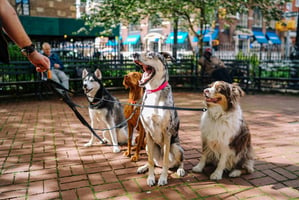Finding blood around your dog's anus can be a worrying sight. It could be a sign of a serious...
Dog Bleeding From Anus Bright Red: Causes and Treatment
A dog bleeding from its anus can be a worrying sight. This article covers the possible causes of bright red blood coming from the anus of a dog, as well as effective treatments. Read on to learn more about the causes, symptoms and treatments of dog bleeding from anus bright red.
Causes of Dog Bleeding From Anus Bright Red
Dog bleeding from anus bright red can be caused by several different issues. The most common cause is anal sac disease, which occurs when the anal sacs become infected or impacted. Other possible causes include anal tumors or polyps, foreign objects in the rectum, rectal prolapse, or trauma to the rectum.
In some cases, dog bleeding from anus bright red can be caused by a bacterial infection or an intestinal parasite. This is more likely if the dog has recently been in contact with other dogs or has recently eaten something that could have been contaminated. It is also possible for a dog to experience bleeding from the anus as a result of a reaction to certain medications or foods.
Symptoms of Dog Bleeding From Anus Bright Red
The most obvious symptom of dog bleeding from anus bright red is the presence of bright red blood. This blood can be visible on the fur around the anus, or it can be seen in the stool. Other symptoms may include straining to defecate, scooting, licking or biting at the anus, and excessive licking or chewing of the rectal area.
In some cases, the dog may also experience pain, discomfort, or a decrease in appetite. If the bleeding is caused by an infection, the dog may also experience fever, lethargy, and vomiting.
Diagnosing Dog Bleeding From Anus Bright Red
If your dog is bleeding from its anus, it is important to take it to the vet for a thorough examination. The vet will take a thorough medical history and perform a physical exam. They may also take a sample of the stool to check for parasites or bacterial infections.
The vet may also perform a rectal exam to check for signs of infection or tumors. An X-ray or ultrasound may be necessary to check for foreign objects or tumors. In some cases, the vet may recommend a biopsy to confirm the diagnosis.
Treating Dog Bleeding From Anus Bright Red
The treatment for dog bleeding from anus bright red will depend on the underlying cause. If the cause is an infection, the vet may prescribe antibiotics or anti-parasitic medications. If the cause is a tumor or foreign object, surgery may be necessary to remove it.
If the cause is anal sac disease, the vet may recommend emptying the anal sacs and treating the infection with antibiotics. In some cases, the vet may recommend a diet change to help improve digestion and reduce the risk of anal sac disease.
The vet may also recommend certain lifestyle changes, such as providing more exercise or reducing stress. It is also important to keep the anal area clean and dry. If your dog is bleeding from its anus, it is important to take it to the vet as soon as possible.
Preventing Dog Bleeding From Anus Bright Red
The best way to prevent dog bleeding from anus bright red is to keep the anal area clean and dry. It is also important to feed your dog a balanced diet and provide plenty of exercise and mental stimulation. If your dog is prone to anal sac disease, it is important to have the anal sacs emptied regularly.
It is also important to keep your dog away from other dogs and any contaminated food or objects. Be sure to monitor your dog for any signs of infection, such as fever, vomiting, or lethargy. If your dog does experience any of these symptoms, take it to the vet as soon as possible.
Conclusion
Dog bleeding from anus bright red can be a worrying sight. However, it is important to remember that there are many possible causes. If your dog is bleeding from its anus, it is important to take it to the vet as soon as possible. The vet can diagnose the underlying cause and provide the necessary treatment.
In addition, it is important to take steps to prevent dog bleeding from anus bright red by keeping the anal area clean and dry, feeding a balanced diet, providing plenty of exercise and mental stimulation, and avoiding contact with other dogs and contaminated food or objects.



